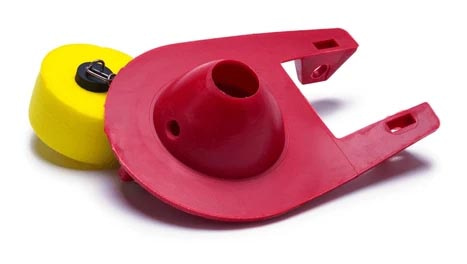Toilets are one of those things that we take for granted until they start to go wrong. When that happens, we suddenly realize just how much of a luxury a properly working John really is. The ability to safely and consistently flush away the waste really is one of the underpinning joys of civilization.
When things do go wrong, it’s important not to panic. Toilets are fairly simple mechanisms really, so it’s usually pretty straightforward to diagnose and fix the issue. When you lift the cistern lid, you’ll be confronted with a few different parts – the chain, the float and a flapper. The exact configuration changes from model to model, but they’re generally pretty easy to identify. Today we’re going to look at one of them: the flapper.
How Does a Toilet Flapper Work?
Regardless of the exact type of toilet you happen to have, all flappers are basically doing the same thing. Their job is to seal the cistern tank until the chain is pulled (or handle flapped, button pushed) and the water is released in a mighty flush.
They come in a few different forms:
- Rubber Flappers: by far the most common
- Plastic Flappers: if there’s an attached float, this is probably what you have
- Adjustable Flappers: ideal for water conservation
When they start to go wrong, you might find that your toilet constantly has a small trickle of water running into the bowl. Alternatively, you might notice that things aren’t flushing away as well as they should. Either way, something has gone wrong in the cistern and it’s probably your toilet flapper not sealing or falling too fast.
Common Toilet Flapper Issues and Their Causes
Despite being a remarkably simple bit of kit, flappers of all types can and will eventually go wrong. You can find a toilet flapper not sealing, a toilet flapper that falls too fast or even one which fails to close at all.
Toilet Flapper Not Sealing Properly
The purpose of your toilet flapper is to create and break a seal around the bottom of your toilet’s cistern. When you flush, the flapper lifts and breaks the seal before falling again and being held in place by the weight of water in the tank.
If something gets in the way of this seal, the result is a toilet which constantly runs (and much higher water bills thanks to all the waste).
There are three main causes for this happening:
- Wear and tear: Rubber perishes as it ages. It becomes less flexible as it dries out and might not seal as tightly as before. Given enough time, bits will even start to break off.
- Mineral build up: Hard water (water with a lot of calcium or other minerals in it) leaves deposits behind. Over time, these will build up in the cistern, making it next to impossible to create a seal.
- Chain issues: Your flapper is connected to your flush mechanisms by a short chain. If this is too tight or tangled up, it’ll constantly be pulling slightly. The result is a toilet flapper not sealing because it’s never quite in the right position.
Toilet Flapper Closing Too Fast
If your toilet flapper falls too fast, it won’t let enough water out of the cistern for an effective flush. While this is good news for the old water bills, it’s terrible news for whoever is in the bathroom after you and, frankly, unsanitary.
It can be caused by two potential problems:
- Float positioned too low: If your toilet uses a float to regulate the toilet flapper and seal, setting it too low means your flapper will close too quickly.
- Incorrect flapper type: Some flappers are designed for low-flush toilets and won’t work properly with other types.
Toilet Flapper Sticking Open
A particularly extreme version of a toilet flapper not sealing is when it sticks fully open. This means that your tank can never quite fill up, your toilet will constantly be running and what flushing you can manage will be ineffective.
There are a couple of potential causes for a flapper not sealing at all:
- Chain too tight: If the chain is too tight, the flapper and seal of the flush valve will never make proper contact.
- Chain stuck under flapper: On the other hand, if the chain is too loose, it could find its way under the flapper and stop it sealing that way.
- Debris or mineral build up: If debris finds its way into your cistern, it’ll be pulled towards the flush valve when you pull the chain. If it sticks there, the effect is much the same as the flapper’s chain getting stuck under there. Likewise, mineral build-up from hard water will naturally congregate there, making it impossible to fully drop the flapper.
How To Diagnose Flapper Problems
Now that we’ve covered the potential mechanisms which can result in a toilet flapper not sealing properly, how do we work out which one you’re facing?
Visual Inspection
The easiest way to diagnose a toilet flapper and seal is to open up your cistern and take a look. A quick visual inspection should be able to identify any obvious signs of wear and tear like, rips or warping. It should also be easy enough to identify if the chain attached to your flapper is too long, too short or has become tangled.
Food Coloring Test
If there’s no obvious cause identified by your visual inspection, add a couple of drops of food coloring to your toilet tank. Wait about 5-10 minutes without flushing and then have a look in the bowl. If you see the color you added, your flapper is definitely leaking and needs more investigation before you can fix it.
Manual Lift Test
If you suspect your toilet flapper isn’t closing properly, try lifting it yourself and see how it lands. Simply open up the cistern tank and pull gently on the chain then release it. Keep a close eye on it as it falls, watching for anything that might be blocking it.
Listen for Running Water
A sure sign of a toilet flapper not sealing is the unmistakable sound of running water after a flush is finished. The only way that water can escape your toilet’s tank is through the flush valve, and the flapper should be sealing that between flushes. If water is getting out, the flapper is almost certainly to blame.
How To Fix A Toilet Flapper That’s Not Sealing Or Closing Properly
How you set about fixing a toilet flapper that’s not working properly depends on the issue you’re facing. All the potential solutions are absolutely achievable on a DIY basis, but if you’re feeling unsure, there’s no shame in calling in the pros.
Cleaning the Flapper and Flush Valve
If you suspect a mineral build up or debris is to blame, clean it out. To do this, follow the steps below:
- Turn off the water
- Flush the tank to drain it
- Remove the flapper
- Soak it in vinegar or a mild cleaner to remove mineral build up
- Sponge the flush valve (the hole at the bottom of your tank) clean.
Adjusting or Replacing the Chain
Your toilet flapper is connected to the rest of the mechanism with a chain. If it’s too long or too short, the flapper won’t work properly. You’re aiming for about ½” of slack when the flapper is sealed.
If it’s too long, simply move the connection to shorten it. If it’s corroded or too short, you’ll have to detach it and replace it.
Replacing the Flapper
Sometimes the simplest way of fixing a toilet flapper is to replace it entirely. To replace a toilet flapper seal simply:
- Make sure your replacement is the right type for your toilet.
- Turn off the water
- Flush to empty the tank
- Disconnect your failed flapper
- Install your new flapper
- Reconnect the chain and ensure everything is aligned properly.
Adjusting the Float
If your flapper is closing too quickly to allow an effective flush, simply adjust the float a little higher. This should allow more water through when you pull the chain.
Preventing Future Toilet Flapper Problems
While nothing lasts forever, there are steps you can take to avoid toilet flapper issues.
Regularly checking for mineral build-up and debris and cleaning it out when you find it and ensuring the cistern is covered to avoid things finding their way in is an easy way to avoid problems developing. If minerals are a problem, consider installing a water softener in your home- your appliances will thank you too.
Avoid using drop-in cleaners. While they’re great for keeping your bowl hygienic, they can damage the rubber on your toilet flapper. Over time, this can and will cause problems.
Finally, consider changing your flapper every two to three years. They’re not expensive and changing them is remarkably quick and simple. This should ensure that you never have to face an inefficient flush again.
When To Call A Plumber for Flapper Issues
If you find that your attempts to fix the issue haven’t worked, calling in the professionals is your next step. Likewise, if, while fixing the toilet flapper, you notice other issues such as inefficient, weak flushes, low water levels or other problems filling the tank, your friendly local plumber can help you out.
If you’re thinking that a toilet upgrade is in order (in the case of older, inefficient models or damage to the flush valve itself), a professional plumber can have it done quickly and efficiently.
Calling in the pros can save you a lot of time, effort and save a lot of waste water too.

